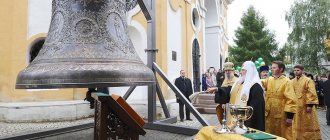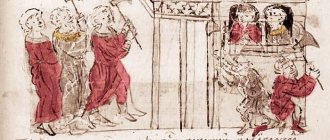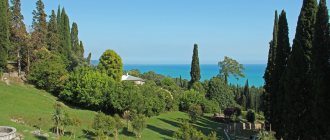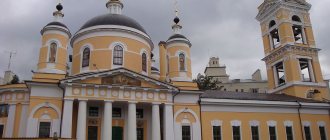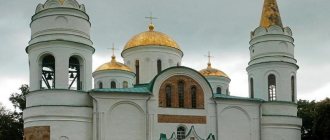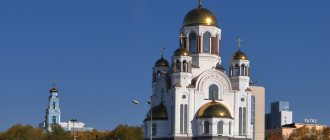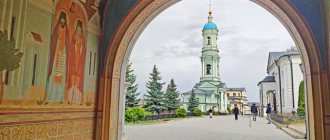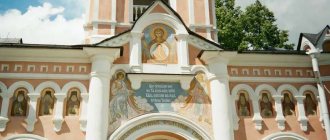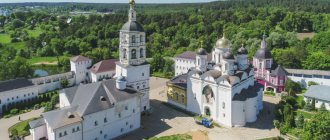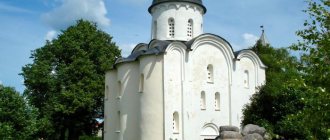History of the holy monastery
In the second half of the 18th century, the Church of the Assumption of the Virgin Mary was built next to the churchyard, located on the outskirts of Yekaterinburg. Soon several nuns settled there and created a small community. Over time, it began to expand and began to be called an almshouse, and the sisters received a monthly salary from the city authorities.
Novotikhvinsky Monastery in Yekaterinburg
As the number of people wishing to join the nuns grew, Abbess Tatiana turned to higher ranks for permission to found a convent. So, in 1809, after a long bureaucratic struggle, the Novo-Tikhvin Hermitage was officially established, and Mother Tatyana took the church name Taisiya.
Becoming
Having learned about the new monastery, women from nearby settlements began to flock to it. The nuns did handicrafts, looked after the elderly and helped the disadvantaged in every possible way. Since there were not enough places for everyone, Taisiya requested permission from the Holy Synod to expand the desert. Having received consent, in 1822 she approved the monastery charter, and a year later the Church of All Saints was solemnly consecrated.
Thanks to the financial assistance of Alexander I, the convent acquired precious church utensils, and construction began on the Alexander Nevsky Cathedral, monastic cells, auxiliary premises, a guest courtyard and buildings for the disadvantaged. Later, the entire territory of the monastery was surrounded by a high stone wall.
After the death of Taisiya (1826), Abbess Alexandra became the new abbess. Under her, a temple in the name of the Mother of God image “Joy of All Who Sorrow” opened, built specifically for the local infirmary. In 1858, the monk died, and instead of her, Mother Magdalene began to perform the duties of abbess. The number of nuns grew tirelessly, which became the reason for the construction of more and more monastery buildings.
When the third abbess passed away (1893), she was replaced by another Magdalene, who continued the activities of her predecessors. Under her, the monastery, in addition to regular divine services and helping those in need, began to engage in educational activities for the local population.
By the beginning of the twentieth century, six churches, infirmary buildings, almshouses were built on the territory of the Novotikhvinsky monastery, and two castles could boast of new churches and auxiliary buildings. The sisters of the women's desert masterfully mastered the technique of painting on porcelain, painting on velvet, engaged in wood and leather burning, and made artificial flower bouquets.
Archive photo of the holy monastery
Years of ruin
During the revolution, the sisters of the monastery did not abandon their usual way of life. However, when the Romanovs were shot, the hermitages were closed, the nuns were sent to prison, and the entire monastery archive was burned. The same fate awaited the ancient manuscripts, which were the pride of the local library. The miraculously saved nuns, under the leadership of Mother Magdalene, organized a community that, as before, continued to help those in need.
The Lavra itself changed dramatically during the reign of the Bolsheviks. Many buildings underwent severe redevelopment, a garbage dump was set up on the site of the necropolis, stone monuments were demolished, and the bells were melted down. Various workshops and institutions were opened in the former monastery buildings, and a military school was also organized there.
Modernity
The Novo-Tikhvin Hermitage received a second life only in 1994 after it came under the control of the Russian Orthodox Church. The institutions that previously occupied the area of the monastery began to be slowly evicted, and the destroyed buildings were actively restored.
In 2000, the Lavra acquired the holy remains of St. Basilisk of Siberia, and a couple of years later - the Great Martyr. Konstantin Bogoyavlensky.
Since 2005, the sisters of the monastery have organized work to collect lost data about the history of the monastery, its abbesses, as well as outstanding nuns. In 2011, the Church of the Assumption of the Virgin Mary was returned to the Novotikhvin Lavra, and two years later the Church of Alexander Nevsky was solemnly consecrated.
Historical description of the Yekaterinburg Novotikhvinsky first-class nunnery
In the last years of the last century, several “orphaned” widows and girls from the city of Yekaterinburg and nearby factories and villages found shelter at the Yekaterinburg Cemetery Church of the Assumption of the Mother of God1. Orphans were placed in a church wooden house, and their number was at first very limited. From this almshouse (that was the name of the orphanage), at first with very meager funds, exactly almost a quarter of a century later, it was destined to form a first-class nunnery, which at present, in its improvement, occupies a very prominent place among other nunneries in Russia . The almshouse, or as it was otherwise called, the community, established with the permission of the spiritual authorities in 17992, received the most insignificant allowance from the local city society and was supported by voluntary donations, and more by the labors of the orphans who lived in it. One of them, Tatyana Andreeva, née Kostromina, who arrived in the community in 1796, was considered the trustee of all orphans and was especially diligent in organizing the community. At the request of this trustee, the Yekaterinburg City Society drew up a verdict on September 25, 1798 to give 4 rubles every month for necessary expenses, such as firewood, candles, etc., along with other orphans. From the public verdict of July 3, 1803, it is clear that since 1799 the society had already given out 10 rubles a month for 15 people. In this verdict, by the way, it is mentioned that a stone building was erected at the cemetery church using voluntary donations, the lower floor of which was then already ready. In the same 1803, the city society elected Ekaterinburg merchant Efim Startsev as a trustee to oversee the completion of buildings and generally the improvement of the community. In February 1806, according to the conviction of the orphans, some residents of Yekaterinburg from different classes opened a subscription for a one-time donation of the amount for the maintenance of a special priest at the cemetery church, so that when this amount was sufficient for the maintenance of the orphanage, they would petition for his appointment. Trustee Tatyana Kostromina also asked the Duma to appoint some kind of allowance for the maintenance of the priest and sexton. On May 14 of the same year, the guardian of “orphaned” wives and girls wrote to the Duma that they were left without any care, and there were up to 25 orphans, and 10 rubles a month of assistance from society was not enough; therefore, she asked the Duma to increase this amount and appoint a trustee instead of the deceased merchant Startsev. Regarding two reports from Trustee Kostromina, firstly, about the insufficiency of the amount allocated for orphans by the Duma, and, secondly, about the need to appoint a special shelter at the cemetery church, the Yekaterinburg City Duma, by resolution on May 28, 1806, decided: 1) signed at the same time by the residents of the city the amount of 946 rubles, upon meeting it, should be converted into city income3, and 180 rubles should be assigned for the maintenance of the priest and sexton and for the food of orphans, and with the previous 120 rubles - 300 rubles. of the non-salary income received by the Duma, which was collected from out-of-town traders (of this income from October 18, 1805 to January 1, 1806, more than 1,000 rubles were received by the parish) “Through what,” added the Duma, “and burdens from the maintenance These orphans and a priest with an orphanage cannot be given to anyone, especially since such unpaid fees apparently must be received every year in considerable quantities from now on.” 2) In place of the deceased merchant Startsev, another should be elected as trustee. The Duma asked the governor to approve this sentence, and contacted the bishop about the appointment of a special priest, “since many of the residents of this city desire it,” the verdict says. This definition of the Duma was approved by the Provincial Board in July of the same 1806.
“Orphaned” widows and girls lived according to the charter of the Sarov communal hermitage, received by Tatiana Kostromina in 1802, during her trip to Kyiv, from the builder of that hermitage, Hieromonk Isaiah4. Upon her arrival in Perm, Kostromina presented this charter to Bishop Justin for consideration. At the hours established according to the Sarov Charter, the sisters gathered in a special prayer cell and prayed according to the available sacred and church books.
“For their exploits, they deserve special attention from the entire city society, and the surrounding residents,” says the “approval” given by the residents of Yekaterinburg to Tatyana Kostromina and her sisters in July 1806, before her departure to St. Petersburg, to seek permission to open a monastery.
In 1807–1809, Tatyana Kostromina lived in St. Petersburg and petitioned for the establishment of a women’s monastery in Yekaterinburg. At this time, she was graciously and favorably received by members of the Holy Synod, especially Metropolitan Ambrose, and the Chief Prosecutor, Prince A.N. Golitsyn. Kostromina received an “approval” from the Yekaterinburg City Society, which contained an approving review of “orphaned” widows and girls and expressed the general desire of citizens to see a monastery approved by the government. “Everything now built by them (the sisters) themselves” (a stone house for the community), it was said, among other things, in “approval”, “the abundance of Holy icons and holy books and even their very behavior is consistent with the monastic stay; The only thing missing is that the higher government would be pleased to approve this place and call it a desert-dwelling monastery.”
In March 1807, Tatyana Kostromina turned to the Holy Synod with the following petition: “Having devoted ourselves to pious deeds and a solitary life, with the blessing of His Grace Archbishop Varlaam of Tobolsk, we have been living since 1799 in a community specially built in Yekaterinburg near the Church of the Assumption Mother of God in public and our support in a stone house, guided by the charter of the Sarov hermitage and practicing fasting, prayers and going to church when service is performed in it, for in the aforementioned church it is not always performed, but only when, as it is part of cemetery, burial is underway. Other churches, due to our residence outside the city, are distant from us; which is why we are forced to correct the divine service in our cells. We spend the rest of the time walking and looking after the sick brought from the city, doing handicrafts and other labors to earn the food we need, receiving three hundred rubles a year as an allowance for this and from the city society for necessary needs.” It is further said that the Yekaterinburg merchants Kalashnikov and Martynov and the tradesman Bronnikov expressed a desire to build with their own money at the mentioned orphanage a stone church, in honor of the Sovereign Emperor, in the name of St. Prince Alexander Nevsky, “to bring the said place of residence to the same level of improvement as other communal monasteries are located, to which the entire city community there unanimously declared its consent.” Kostromina asked to approve the community or order the erection of a church in the name of St. Alexander Nevsky. “And in which” (i.e., the community), she wrote, “to the extent of the excess proceeds from our handicrafts and brought by willing donors, in fulfillment of works of mercy, charity will be arranged for the poor and infirm, brought from the city and its environs, for whom there will be there will be walking and care of the local novices themselves, which is still being carried out to glorify the Name of God, and in order to perpetuate this society, provide permission for this construction, ordering to assign to it a priest with a shelter, whose maintenance the city society will accept for itself.”
In the petition of the merchant Kalashnikov, submitted to the Holy Synod, for permission for him, Martynov and Bronnikov, to build a church in the name of the Holy Blessed Prince Alexander Nevsky, the urgent need for this is expressed: “... Since the aforementioned widows and girls are leading a life similar to a monastic one, according to the charter of the Sarov hostel desert, and they send the praise of God in the prayer room, to hear which quite a number of people flock to them from the inhabitants, so that sometimes the designated room is not spacious enough.” On March 5, 1808, His Eminence Justin asked the head of the Yekaterinburg factories to provide information about whether the society really agreed to establish a monastery and build a church with it with the purpose of a special shelter. The head of the mining works reported to Bishop Justin in the affirmative. As can be seen from the message to the Perm Spiritual Consistory of the head of the Ekaterinburg factories Herman dated March 23, 1808, the widow of the Provincial Secretary Isakov, who remained the trustee of the community after Kostromina left for St. Petersburg, presented to this chief that if the Government was pleased to establish the requested monastery, then “they ( sisters) extend a true desire to undertake the most tireless work in all godly affairs and, moreover, from willing Ekaterinburg citizens they will accept female children to teach Russian literacy and various handicrafts characteristic of their strengths, and also, in a manner befitting their gender, they can receive and look after the elderly and in the illnesses of suffering people, poor relatives and from strangers there is no protection, with special help due to those sick”... On November 14, 1808, the head of the Yekaterinburg factories submitted a list of sisters living in the community to the Perm Spiritual Consistory. There were 33 of them in total. By class they were distributed as follows: noble 4, peasant 15, bourgeois 1, miner 10, soldier 3. By place of residence: from Yekaterinburg and its district 25 people, from Kamyshlovsky district 4, from Turinsk 1, from Yalutorovsk 1, from Solikamsk 2. By age there were: from 50 to 80 years old 8 people, from 40 to 50 – 4, from 30 to 40 – 8, from 20 to 30 – 6, from 10 to 20 - 5, and under 10 years old - 2. There were 7 widows, and 26 girls.
1808 On June 25, Tatyana Kostromina submitted a most loyal petition for the establishment of a communal hermitage, for permission to build a church there in the name of St. Alexander Nevsky and for the appointment of a trustee, instead of the deceased merchant, Archpriest of the Church of the Epiphany Nicholas of Vologda, who greatly contributed to the organization of the community5.
According to the personal Highest decree given to the Holy Synod of 1809, December 31, a dormitory women's monastery was established in Yekaterinburg with its name Novotikhvinskaya, in accordance with the desire of the entire city noble, merchant and bourgeois society, as well as the Head of the mining factories and the Governor-General of Perm and Vyatka6 . The monastery is subordinate to the department of the diocesan Bishop. There were supposed to be seventeen monastics with the abbess, as in regular third-class convents. The abbess of the monastery, by decree of the Holy Synod on September 20, 1810, was named nun Taisia, known as Tatyana (née Kostromina), who was often mentioned above.
Tatyana Kostromina, monastic Taisiya, daughter of the Verkh-Isetsky factory foreman Andrei Kostromin, was married to the Berezovsky factory foreman Pyotr Sergeev Mitrofanov, who was sent to military service in 1782 and died on December 22, 1806. Tatyana Kostromina was tonsured a monk on August 7, 1810 in St. Petersburg, in the Resurrection Nunnery, by the archimandrite of the Tobolsk Znamensky Monastery, Mikhail, and was named Taisia. On June 11, 1811, upon returning from St. Petersburg, nun Taisia was ordained by Bishop Justin at the Perm Peter and Paul Cathedral in Abbess “in respect of her zeal and godly deeds in the establishment and arrangement of the desert.”
In the same year, 1811, nun Eupraxia, who was dismissed from the Moscow Nikitsky nunnery, was appointed treasurer of the monastery. Being with the abbess Taisia, upon her return from St. Petersburg, four maidens Agafia, Vassa, Matrona and Anna were tonsured in Perm by Bishop Justin as robed nuns, since they had previously been in the art of monasticism, and the first was appointed as an assistant treasurer, the second as a sacristan and the third is a charterer. The latter was allowed to form a choir of singers from the sisters, so that the clerks assigned according to the state would not interfere with the singing in the choir. For priestly services in the church, at first one priest and two clerics were assigned to the monastery, and instead of the cemetery church it was allowed to build another one, at the expense of the Ekaterinburg citizens who were zealous in this matter, the merchants Kalashnikov and Martynov and the tradesman Bronnikov. In 1811, in addition to the state requirement of one priest with a clergy, at the request of Abbess Taisia, another priest was appointed for daily priestly service in the monastery. The priests at this time were from the supernumerary Elisey Ryazanov and Alexander Voinstvensky, to whom the diocesan authorities ordered “regarding their service in the desert to be with the clergy under the orders of the abbess unquestioningly, without interfering with any matters or order related to the desert.” On Sundays and holidays, for the cathedral priestly service in the church, it was allowed to take one of the deacons of St. Catherine’s Cathedral in turn, and in case of illness of one of them, from other parish churches. The salary of the priests with the clergy, by agreement between them and the abbess and with the approval of the diocesan authorities, was assigned from the amount of three hundred rubles set by the Yekaterinburg City Duma. The income received by clergy from the correction of church services was ordered to be divided monthly into three parts: two for priests, and a third for sextons. The clergy did not have to contribute to the “nuns’” income, and these incomes, since the monastery was established as a dormitory, were not divided among the nuns, but were accumulated into a total amount and from it the treasurer made expenses, from the report of the abbess, for the maintenance and needs of the sisters, “and also for treating the abbess’s guests.”
For the safety of the desert from malicious people, which in reality turned out to be, the abbess was asked to ask the Yekaterinburg society for the necessary guards. since the Novotikhvinskaya hermitage, according to the Highest command, is compared with third-class convents, in which, according to the staff approved by the Highest in 1764, there are supposed to be three ministers for the protection of those monasteries and for the services that happen, then for the protection of this desert - according to the Highest command established and, moreover, at the request of the Ekaterinburg citizens themselves, with an obligation on their part to provide possible benefits to the desert in case of necessary needs - the abbess in 1811 asked the Ekaterinburg City Duma, so that it would favor, in respect of the danger from malicious people, also to choose from his company of three people of honest and good behavior, with the production of a salary to them from the company. At the same time, the abbess asked the Duma to send one of the literate ministers so that he could engage in writing in the monastery “in the event of any correspondence in the desert with public places or authorities.” But the Duma did not satisfy this request, responding that society already bears very significant obligations and that its income is not enough for the most necessary expenses, and most importantly, that the government has not assigned this responsibility to society. In 1815, the then head of the mining factories took part in protecting the monastery from malicious people and in general in its organization. On February 2, 1815, Abbess Taisiya reported to Bishop Justin that the head of the Yekaterinburg mining plants N.A. Shlenev granted the monastery two men and a third carpenter to guard the monastery and promised to help in every possible way during the construction works being carried out at the monastery at that time. The highest civil authorities took measures to protect the security of the monastery, transforming it into a first-class monastery in 1822. This year, as a result of the petition of Abbess Taisia, by order of the Minister of Finance, the Department of Mining and Salt Affairs ordered the head of the Yekaterinburg factories to have special supervision over security and the tranquility of the monastery, especially in cases of attempted robbery by malicious people. Therefore, the Coin Office sent artisans to the monastery to guard it until October 1823, when the regular servants entered the monastery.
Upon returning from St. Petersburg in June 1811, Abbess Taisiya presented to Bishop Justin in Perm twenty-five pieces of holy relics given to her, at the suggestion of Metropolitan Ambrose of Novgorod, from the Novgorod Cathedral of St. Sophia for the Novotikhvin monastery. After the sacred rite of consecration of water was completed on June 11 in the Peter and Paul Cathedral, the holy relics were placed in an image specially made for this purpose and on the same date, together with the icon of the Tikhvin Mother of God, they were transported with a sacred ceremony to the city of Yekaterinburg, into which they were brought on June 26, the day of Tikhvin Mother of God. A procession of the cross was held around the monastery and the entire city, which still happens every year on this day. The diocesan authorities allowed the image with holy relics and the mentioned icon to be worn for prayer services and all-night vigils in the homes of citizens and surrounding villages. “Everywhere one could see the same zeal of Christians for accepting icons into houses for prayers,” Abbess Taisiya reported to Bishop Justin on December 9, 1813. During the religious procession in different counties, a significant collection was received in favor of the monastery. On November 9, 1812, Abbess Taisiya reported to the Right Reverend that on September 7 of that year the icon and image with holy relics were raised and carried around the cities of Kamyshlov, Dalmatovo and surrounding villages until November 4. During the walk, a butt was attached both to the church and to the monastery, in money 611 rubles. 13 kopecks, one thousand and a half arshins of canvas and 6 poods of tow. and 3 lbs. On November 14, 1813, it was reported to Bishop Justin that while walking with the icon of the Tikhvin Mother of God through the cities and districts: Verkhoturye, Irbit, Kamyshlovsky, Shadrinsky and Yekaterinburg, only 1,634 rubles were received from those who were zealous for the decoration and maintenance of the monastery. 67 kop., various canvas 3.252 arsh. and tows about two pounds. Abbess Taisiya, in a report dated February 6, 1812, asked for official permission to wear the icon throughout the diocese. In response to Bishop Justin's demand from all clergy and parishioners of the diocese for information whether they wish to accept the image of the Tikhvin Mother of God and the cross with various relics, the following responses were received, by the way. They did not declare a desire to adopt this image: 1) in the Shadrinsky district, everyone, 2} in the Krasnoufimsky district in the Utkinsk, Verkhneserginsky and Sylvensky factories, 3) in the Yekaterinburg - in one Shaitansky plant, 4) in the Irbitsky in the villages: Gulyaevsky, Churmansky, Berezovsky, Podvoloshchensky and Bazhenovsky and in the settlements: Bobrovskaya, Krasnoslobodskaya, Baikalovskaya, Ilenskaya, Kharlovskaya, Chubarovskaya and Elanskaya, 5) in Perm - in one Perm village, 6) in Osinsky - all parishioners and 7) in Kamyshlovsky - they agreed to accept in just one year . The Yekaterinburg clergy responded that they consider accepting the icon to be a deed pleasing to God, but they find it inconvenient to do this on the days designated for processions and ceremonies (on Holy Week); all the inconveniences were calculated in detail, especially the clergy rebelled against the permission to sell monastery candles in city churches and collect cinders for the benefit of the monastery, which they considered contrary to the Highest command and which could result in an extreme decrease in the amount of candles in the churches. The church elders were of the same opinion as the clergy. Therefore, Bishop Justin ordered, on June 17, 1814, that during the wearing of the icon and prayers “the sale of candles should be carried out not from the monastery, but from the parish churches, and that prayers should be corrected in churches and houses alternately by the monastery priest and the parish priest.” Both priests were ordered to divide the income they received in half. The icon was allowed to be carried to all those places where consent was declared by the clergy and parishioners.
At the end of the thirties, the diocesan authorities considered it necessary not to allow walking around the diocese with an icon and image with holy relics. Back in the early 30s, each time permission was sought to raise and carry icons and images throughout the diocese. So, for example, on July 26, 1830, Abbess Alexandra asked His Grace Meletius for permission to carry the image with holy relics and the icon of the Tikhvin Mother of God throughout the cities, factories and villages of the entire diocese every year after Easter. The Most Reverend Meletius gave permission and together prescribed, dated August 26, 1830, that “to wear the mentioned shrines, nuns of constantly honest behavior and the most trustworthy were chosen and so that, during their walk, they observe all piety and silence, all reverence for the shrines they wear. and in their behavior under no circumstances did they allow any indecency and any actions that would be tempting to produce those who could.” The shrines were sent from the monastery in the spring of the following 1831. The nun Ilaria was appointed to collect the butts during the sacred ceremony, and with her were sent another ryasophore nun, three novices and four squirrel singers. From the Mother Superior and the sisters, the following instructions were given to nun Ilaria: 1) to strictly observe all decorum and silence during her walk, and all reverence and veneration for the icons worn; 2) to have the most vigilant supervision over the morality and behavior of all sisters, especially those in the choir, so that they do not at all and under any circumstances allow in their behavior any indecency or misconduct, any contradictions and disagreements among themselves, as well as mockery and laughter, the temptation to produce potential ; in case of indiscretions noticed in them, privately punish them, according to the extent of guilt, with bows or sensitive reprimands and, if they do not correct themselves, inform the Mother Superior herself; 3) in dealing with people, observe all prudence, modesty, chastity, humility, reverence, in a word, behave as monastic duty requires, and through this instill a high opinion of the monastery itself. During the wearing of the icon from May 5, 1831 to January 7, 1832 in the factories - Nevyansk, Tagil, Rezhevsky, Alapaevsky and some villages along the Verkhoturye tract, then in Verkhoturye and in the Bogoslovsky and Goroblagodatsky factories, “everywhere it was seen as noble persons, Equally, the clergy and common people showed special Christian reverence and zeal for the shrines they wore, and they collected 7,800 rubles for the church and monastery, 2,500 arsh for various canvases, 6 poods of candle cinders. 20 f. (Report dated February 8, 1832). From the Goroblagodat factories, the circulation of the shrines was continued in the Kungur, Perm and Solikamsk districts: 6,262 rubles were collected. 50 kopecks, candle wax cinders 6 pounds. 37 f., various canvas over 3000 arsh. In addition, during the entire walk, various low-value items worth about 200 rubles were collected. They returned to the monastery with the shrines at the beginning of 1833.
On June 20, 1833, Abbess Alexandra addressed the Right Reverend Bishop Arkady with a request for permission to continue walking with only the icon of the Tikhvin Mother of God without holy relics, along the highway to Sysertsky, Polevsky, Kaslinsky, Kyshtymsky and other district factories and villages and from there to Shadrinsk and Kamyshlov. But this time, walking with the icon was ordered to be suspended until the monastery was accounted for by the clergy appointed for this by decree of the consistory.
Through the care of Abbess Taisia and the generosity of various benefactors, the following buildings were built at the monastery before it was transformed into a first-class monastery: 1) to the cemetery Assumption Church, which existed before the establishment of the monastery, a two-story stone extension was built on the western side, in which the lower floor is called the narthex or refectory, and in the upper one there are two tents for storing the sacristy; On the noon side there are two schematic cells attached.
2) A stone chapel was built, which was subsequently converted into a church in the name of All Saints in 1822.
3) A new stone Alexander Nevsky Church was built, but not completely finished, which, although the merchants Kalashnikov and Martynov and the tradesman Bronnikov undertook to build at their own expense, due to the disorder of their condition, the monastery did not help at all in the construction of this church.
All these church buildings are covered with iron.
4) Stone buildings were built: three buildings and a fourth outbuilding. The first building, two floors with four attics, contained, in addition to the abbot's cells, 20 chambers and a corridor in the middle; From this building to the church there is a wooden corridor with the same roof. The second building is two-story for nuns, with two attics, covered with a wooden roof; both floors and attics housed 11 cells and a corridor. The third three-story building is covered with wood; There are 8 cells on all floors. A two-story outbuilding with a wooden extension and wooden services; There are 4 rooms on both floors. Covered entirely with wood.
5) Four wooden buildings were built: a two-story house with an attic on a stone foundation, containing 6 chambers; one-story outbuilding with two chambers; an outbuilding at the gates of the monastery with two chambers and a corridor and, finally, a stable yard, with stables, imports and grain stores.
All these buildings, stone and wooden, are surrounded on two front sides by a stone fence, and on the other two by a wooden fence.
Outside the monastery there were two stone one-story houses: the first was 60 fathoms from the monastery with two attics and a chapel, which were covered with iron, and the house was made of wood, in it and the attics there were 8 chambers and a corridor; fenced on two front sides by stone pillars with wooden gratings, and on the other two sides by fences. The second house, 70 fathoms from the monastery, with two attics, is fenced on two front sides with a stone fence; there are 6 chambers in it and two chambers in the wooden outbuilding attached to the house. These two stone houses were built by the Mother Superior for the clergy.
In all the monastery buildings, houses and wings, except for the abbot's cells, there were 71 chambers, which could freely accommodate up to 150 people.
Under Abbess Taisiya, during the construction of wooden and stone ones, in the absence of servants, the sisters themselves carried bricks, carried timber and did other hard work. In winter, by the way, the sisters removed snow.
The main office of the Yekaterinburg factories, at the request of Abbess Taisia, also allocated monasteries of the following sizes. According to the plan given on November 13, 1814, for the two places allocated for the construction of church and ministerial houses, an area of land of 10,300 square meters is shown. fathoms Under the first place the length is 100 and the diameter is 40 fathoms; under the second the length is 70 and the diameter is 30 soots. In these places, in the summer of 1814, two stone houses were built: for the clergy and a receiving house for overnight stays for lay people coming from surrounding places on church holidays; the first is 10 fathoms long and 7 fathoms across. and the second is 7 fathoms long and 3 fathoms wide. According to the plan given on July 20, 1815, an area of land of 18 tens is shown for a swamp area in a tract near the small Kamenny Lake for clearing for haymaking and for an eternal monastery. 782 soot
According to the plan given on May 19, 1817, the space allocated for the monastery for a cemetery and for an estate shows a space of 24 tens. 1300 soot.
The Most Reverend Bishop Justin, after examining the plans presented by Abbess Taisiya on May 8, 1819, of which one with the facades of the manufactured buildings, and the other the places allocated by the main office of the Yekaterinburg factories for the monastery and the cemetery church, found these places to be very sufficient and, having approved the plans, proposed to the Consistory report to the Chief Head of Mining Plants N.A. To Shlenev the most sensitive gratitude for his patronage, care and his diligent goodwill towards the desert being built. To the abbess, Abbess Taisia, the diocesan authorities declared gratitude, praise and complete pleasure for her tireless activity in choosing and soliciting places both for the desert and for church and ministerial houses, as well as for the successful arrangement of monastic cells and services, enclosing them with stone fences and for prudent forethought and speed in building two stone houses near the desert for the clergy7.
Due to the orders of Abbess Taisia, the following handicraft, agricultural and other activities were introduced into the monastery to support the sisters and to maintain the above-mentioned buildings: 1) handicrafts: a) yarn of flax, cotton paper and wool, weaving and bleaching of different types of canvas, also weaving canvas for tablecloths and napkins, blankets, cloth, etc.; b) sewing on velvet and other materials with silks, gold and silver, shrouds, banners, covers for chalice and paten and all church and sacristy utensils and other similar items for private individuals,8 and c) making various patterned vestments for holy icons from gold and silver thread, foil and tinsel9.
2) Agricultural activities: a) sowing various grains, flax and hemp on forage lands; b) cultivation of all kinds of vegetables, both for food for the sisters and for sale to citizens; c) picking mushrooms and berries during the summer; d) cattle breeding and fishing in lakes and rivers convenient and close to the monastery, and e) haymaking in an empty swamp place, which was taken for drainage for 12 years from the main office of the Yekaterinburg factories on September 12, 1816; this activity brought great benefits to the monastery. 3) Other activities: since a place was designated for a cemetery near the monastery itself and a church was built on it, at the expense of the monastery, then a) the monastery prepared graves for dead bodies, with the receipt of money or contributions for the benefit of the monastery; b) the sisters read psalms and canons, and also commemorated the dead, according to their wills or at the request and zeal of their relatives, with payment from them in money, contributions or other benefits for the desert, and c) reserves were prepared for the cemetery church wax and candles, with the profit from them being used for the benefit of the desert as well.
For her services rendered in establishing the monastery, Abbess Taisiya was awarded a golden pectoral cross on January 18, 1820. His Eminence Justin, in a report dated October 23, 1819, reported to the Holy Synod that in such a short time the monastery was decorated with churches of the Lord and expanded with extensive buildings, thanks to “zeal, zeal, vigilant and prudent care and activity” of Abbess Taisia. The Holy Synod made the following determination: “Upon consideration of the above-mentioned report of His Eminence and the plan of the Ekaterinburg Novotikhvinsky convent, presented by the Abbess Taisiya, signed by His Eminence, the Holy Synod finds that the arrangement of all this was due to the efforts of her, the Abbess, and the maintenance of those living in the monastery such a number of nuns and belitsa10 without any benefit from the treasury deserves respect, and therefore, as reward for it and as encouragement for future similar works and exploits, he honors her, Abbess, with a golden pectoral cross.” The Sovereign Emperor, according to the mentioned definition of the Holy Synod, most mercifully deigned to command: “to award the Abbess Taisia of the Novotikhvinsky convent established in Yekaterinburg with a golden pectoral cross, in respect of the merits rendered in the establishment of the monastery entrusted to her, in encouragement of her diligent service in the future.” (Decree from the Consistory of April 13, 1820)
Architecture Features
The Ekaterinburg Novo-Tikhvin Monastery is a luxurious architectural complex in which all elements harmoniously complement each other.
Cathedral in the name of Alexander Nevsky
The foundation of the Alexander Nevsky Church was laid in 1814 as a tribute to the victory over Napoleon. However, due to an unsuccessful project, the work was somewhat delayed. Thus, the main altar was consecrated only in 1852, the left altar in 1853, the right altar in 1854. By the time the cathedral opened its doors to believers, it was considered the largest church building and could accommodate about 6,000 people.
The five-tiered temple was built in the classicist style under the leadership of the architect Mikhail Pavlovich Malakhov. The building is five-domed, with spherical gilded domes ending in Orthodox crosses. The façade is decorated with columns, and a tall bell tower with a spire is built nearby.
Interior of the Church of St. Alexander Nevsky of the Novo-Tikhvin Monastery
Temple of All Saints
The church dates from 1900-1902. and is a single-domed building made in the neo-Byzantine style. The walls are lined with red brick, which harmoniously combines with the hemispherical dome of the same color. Erected on the site of an old chapel, it initially served as a hospital church. Today, the main shrines of the monastery are kept here - the Tikhvin image of the Mother of God and the miraculous remains of 25 saints.
Architectural ensemble of the monastery facade
The first and only architectural ensemble in Russian Orthodox architecture. It consists of three churches (Vvedenskaya, Skorbyashchenskaya, Feodosievskaya) and cell buildings with a total length of about 100 m. With the Bolsheviks coming to power, the “House of the Red Army” was built here, and the buildings were somewhat reconstructed - the domes were removed, and crenellated sides were installed instead as a symbol the power of the Soviet troops.
Temple in the name of the icon of the Mother of God “Joy of All Who Sorrow”
The church was erected in 1832 and served as a refectory church. The architecture of the building clearly expresses the classicism style inherent in most of the buildings of the monastery complex. The Cathedral of “Joy of All Who Sorrow” is built of stone, has one hemispherical dome and is lined with light plaster.
Church in honor of the Entry into the Temple of the Blessed Virgin Mary
Another one of the most ancient temples, consecrated in 1865. Like most local buildings, it has a single dome, but today, instead of a spherical dome, it is decorated with jagged sides. To return the church to its original appearance, it is necessary to prepare a high-quality project, work on which has already begun.
Temple in honor of St. Theodosius of Totem
To date, only the temple apse has been transferred into the possession of the monastery, and restoration work has not yet begun. The two-story building is made in the classicist style and dates back to 1823. Initially it was a house church, but after the revolution the building was converted for civil needs.
According to legend, a rider on a snow-white horse appeared in a dream to Mother Taisia, who gave her an icon of St. Feodosia. In the future, the cathedral was consecrated by the name of this saint.
Compound in honor of the All-Merciful Savior
The temple is located on the Elizavetinskaya Zaimka, where it was erected in 1876. It has three altars and five domes with small belfries. Since the church burned three times in its entire history, by the time it was transferred to the Russian Orthodox Church it was almost completely destroyed. Today it has been restored, but restoration work is still underway.
Alexander Nevsky Cathedral
Temple of All Saints
Compound in honor of the All-Merciful Savior
The main attractions of the monastery
Assumption Church. The oldest on its territory. It was rebuilt with donations from the merchant Khlepetin back in 1778–1782. It was rebuilt and expanded more than once.
Alexander Nevsky Cathedral. The dominant feature of the monastery is its largest temple. Previously, it dominated architectural objects in this part of Yekaterinburg. During holiday services it could accommodate more than 6 thousand people. Now rebuilt, it impresses with its beauty.
All Saints Church. It was built in 1900. The work was financed by another Yekaterinburg merchant and philanthropist - M. I. Ivanov.
Shrines and honored dates
The main shrine of the Novo-Tikhvin Convent is the miraculous image of the Mother of God “Tikhvin”. You can also see here other church relics, in particular, the remains of some saints:
- Alexander Nevsky;
- 25 God's saints;
- St. Nicholas the Wonderworker;
- Kiev-Pechersk saints;
- Fedora Ushakova;
- St. Basilisk of Siberia;
- Simeon of Verkhoturye;
- St. Cyprian and Justina;
- sschmch. Konstantin Merkushinsky;
- St. Mary of Egypt.
The women's monastery in Yekaterinburg celebrates several patronal holidays:
- December 6, September 12 – Memorial Day of Alexander Nevsky;
- August 28 – Dormition of the Mother of God;
- November 6 is the date of veneration of the miraculous image of the Mother of God “Joy of All Who Sorrow”;
- August 19 – Transfiguration of the Lord;
- December 4 – introduction of the Blessed Virgin Mary into the temple;
- February 10 is the day of remembrance of St. Theodosius of Totemsky;
- The first Sunday after Pentecost is the Synaxis of All Saints.
Relics of Alexander Nevsky
Information for pilgrims
Despite active restoration work, the Novo-Tikhvin Convent is open to visitors every day.
Activities of the parish
In addition to regular church services, the Lavra is actively involved in social and educational activities. Within the monastery walls there is a canteen for the poor, there is a warehouse of free clothes for those in need, there is its own publishing house, as well as an icon-painting workshop.
Divine service in the monastery
The schedule in the desert remains virtually unchanged. Divine services are held every day from 7:30 to 17:00. On holidays, the Divine Liturgy begins at 6:00, and on Sundays at 17:00 there is a joint prayer service to the Tikhvin Icon of the Mother of God.
The sacrament of confession in the Ekaterinburg convent takes place on Fridays and Saturdays from 16:00 to 19:00.
Author's advice
Worship services are held every day
Address and how to get there
Novotikhvinsky Convent is located at the address: Yekaterinburg, st. Zolotaya Roshcha, 1. You can get there by bus No. 23, going to the Geologicheskaya stop.
The Russian land is rich in Orthodox shrines. The Novo-Tikhvin Hermitage, which is located in the largest Ural city, is truly a masterpiece complex that is worth visiting for every pilgrim.
If you find an error, please select a piece of text and press Ctrl+Enter.
